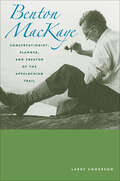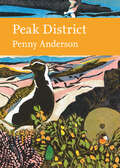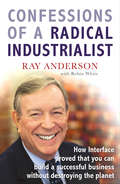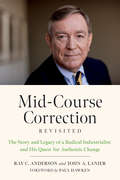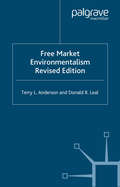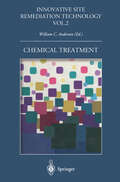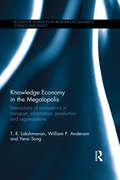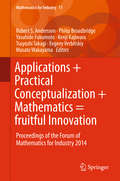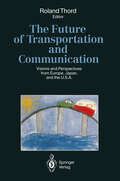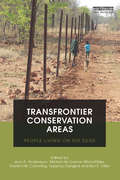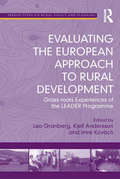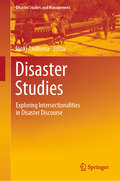- Table View
- List View
Design Energy Simulation for Architects: Guide to 3D Graphics
by Kjell AndersonLeading architectural firms are now using in-house design simulation to help make more sustainable design decisions. Taking advantage of these new tools requires understanding of what can be done with simulation, how to do it, and how to interpret the results. This software-agnostic book, which is intended for you to use as a professional architect, shows you how to reduce the energy use of all buildings using simulation for shading, daylighting, airflow, and energy modeling. Written by a practicing architect who specializes in design simulation, the book includes 30 case studies of net-zero buildings, as well as of projects with less lofty goals, to demonstrate how energy simulation has helped designers make early decisions. Within each case study, author Kjell Anderson mentions the software used, how the simulation was set up, and how the project team used the simulation to make design decisions. Chapters and case studies are written so that you learn general concepts without being tied to particular software. Each chapter builds on the theory from previous chapters, includes a summary of concept-level hand calculations (if applicable), and gives comprehensive explanations with graphic examples. Additional topics include simulation basics, comfort, climate analysis, a discussion on how simulation is integrated into some firms, and an overview of some popular design simulation software.
Design Energy Simulation for Architects: Guide to 3D Graphics
by Kjell AndersonLeading architectural firms are now using in-house design simulation to help make more sustainable design decisions. Taking advantage of these new tools requires understanding of what can be done with simulation, how to do it, and how to interpret the results. This software-agnostic book, which is intended for you to use as a professional architect, shows you how to reduce the energy use of all buildings using simulation for shading, daylighting, airflow, and energy modeling. Written by a practicing architect who specializes in design simulation, the book includes 30 case studies of net-zero buildings, as well as of projects with less lofty goals, to demonstrate how energy simulation has helped designers make early decisions. Within each case study, author Kjell Anderson mentions the software used, how the simulation was set up, and how the project team used the simulation to make design decisions. Chapters and case studies are written so that you learn general concepts without being tied to particular software. Each chapter builds on the theory from previous chapters, includes a summary of concept-level hand calculations (if applicable), and gives comprehensive explanations with graphic examples. Additional topics include simulation basics, comfort, climate analysis, a discussion on how simulation is integrated into some firms, and an overview of some popular design simulation software.
Benton MacKaye: Conservationist, Planner, and Creator of the Appalachian Trail (Creating the North American Landscape)
by Larry AndersonPlanner and originator of the Appalachian Trail and a cofounder of the Wilderness Society, Benton MacKaye (1879-1975) was a pioneer in linking the concepts of preservation and recreation. Spanning three-quarters of a century, his long and productive career had a major impact on emerging movements in conservation, environmentalism, and regional planning. MacKaye's seminal ideas on outdoor recreation, wilderness protection, land-use planning, community development, and transportation have inspired generations of activists, professionals, and adventurers seeking to strike a harmonious balance between human need and the natural environment.This pathbreaking biography provides the first complete portrait of this significant and unique figure in American environmental, intellectual, and cultural history. Drawing on extensive research, Larry Anderson traces MacKaye's extensive career, examines his many published works, and describes the importance of MacKaye's relationships with such influential figures as Lewis Mumford, Aldo Leopold, and Walter Lippmann. This book will appeal to students, scholars, and professionals in preservation, conservation, recreation, planning, and American studies, as well as general readers interested in these subjects.
Benton MacKaye: Conservationist, Planner, and Creator of the Appalachian Trail (Creating the North American Landscape)
by Larry AndersonPlanner and originator of the Appalachian Trail and a cofounder of the Wilderness Society, Benton MacKaye (1879-1975) was a pioneer in linking the concepts of preservation and recreation. Spanning three-quarters of a century, his long and productive career had a major impact on emerging movements in conservation, environmentalism, and regional planning. MacKaye's seminal ideas on outdoor recreation, wilderness protection, land-use planning, community development, and transportation have inspired generations of activists, professionals, and adventurers seeking to strike a harmonious balance between human need and the natural environment.This pathbreaking biography provides the first complete portrait of this significant and unique figure in American environmental, intellectual, and cultural history. Drawing on extensive research, Larry Anderson traces MacKaye's extensive career, examines his many published works, and describes the importance of MacKaye's relationships with such influential figures as Lewis Mumford, Aldo Leopold, and Walter Lippmann. This book will appeal to students, scholars, and professionals in preservation, conservation, recreation, planning, and American studies, as well as general readers interested in these subjects.
Equations of State for Solids in Geophysics and Ceramic Science (Oxford Monographs on Geology and Geophysics)
by Orson AndersonWritten by a renowned expert in the field, this book is the most comprehensive treatment available on the applications of equations of state (EoS) in geophysics and materials science, a topic of fundamental importance to those studying the physics and chemistry of the Earth. Part one offers comprehensive treatments of thermal properties associated with EoS, thermodynamic and statistical mechanical backgrounds, and thermoelastic properties. Definitions of the physical properties needed for the EoS are provided as well. Part two discusses the isothermal pressure-volume relationship. The ab initio approach--EoS based upon quantum mechanics fundamentals using numerical methods--is utilized to clearly represent and analyze the measured data. Part three offers an advanced treatment of thermal properties at high temperature, and includes discussions of thermal pressure, shocked solids, and EoS applications to materials science topics such as melting and thermodynamic function. Advanced students, researchers, and professionals in geophysics, ceramics science, solid state physics, and geochemistry will want to read this book.
Peak District (Collins New Naturalist Library)
by Penny AndersonThe Peak District, Britain’s first national park, is a land of great natural beauty, visited by millions of people every year.
Confessions of a Radical Industrialist: How Interface proved that you can build a successful business without destroying the planet
by Ray AndersonIn 1994, Ray Anderson felt a 'spear in the chest': he realised that his company, billion-dollar carpeting manufacturer Interface, Inc, was plundering the environment with its unsustainable business practices, and that it desperately needed to change direction. Under his leadership, Interface went on to set unprecedented targets for cutting waste, instigated revolutionary recycling initiatives, and encouraged employees at every level of the company to contribute ideas on how to save resources. As a result, the company's greenhouse gas emissions decreased by 82% and are on target to reach zero level by 2020. Not only that, these changes also brought down costs, improved quality, and increased profits. In Confessions of a Radical Industrialist, Ray Anderson shares the remarkable story of how Interface turned itself around, and proves that running your company sustainably isn't radical at all - it's just good business.
Mid-Course Correction Revisited: The Story and Legacy of a Radical Industrialist and his Quest for Authentic Change
by Ray Anderson John A. LanierThe original Mid-Course Correction, published 20 years ago, became a classic in the sustainability field. It put forth a new vision for what its author, Ray C. Anderson, called the “prototypical company of the 21st century”—a restorative company that does no harm to society or the environment. In it Anderson recounts his eureka moment as founder and leader of Interface, Inc., one of the world’s largest carpet and flooring companies, and one that was doing business in all the usual ways. Bit by bit, he began learning how much environmental destruction companies like his had caused, prompting him to make a radical change. Mid-Course Correction not only outlined what eco-centered leadership looks like, it also mapped out a specific set of goals for Anderson’s company to eliminate its environmental footprint. Those goals remain visionary even today, and this second edition delves into how Interface worked toward making them a reality, birthing one of the most innovative and successful corporate sustainability efforts in the world. The new edition also explores why we need to create not only prototypical companies, but also the prototypical economy of the twenty-first century. As our global economy shifts toward sustainability, challenges like building the circular economy and reversing global warming present tremendous opportunities for business and industry. Mid-Course Correction Revisted contains a new foreword by Paul Hawken, several new chapters by Ray C. Anderson Foundation executive director John A. Lanier, and interviews with Janine Benyus, Joel Makower, Andrew Winston, Ellen MacArthur and other leaders in green enterprise, the circular economy, and biomimicry. A wide range of business readers—from sustainability professionals to green entrepreneurs to CEOs—will find both wise advice and concrete examples in this new look at a master in corporate and environmental leadership, and the legacy he left.
Introduction to Development Engineering: A Framework with Applications from the Field
by Richard Anderson Kenneth Lee Temina Madon Ashok J. Gadgil Lorenzo Casaburi Arman RezaeeThis open access textbook introduces the emerging field of Development Engineering and its constituent theories, methods, and applications. It is both a teaching text for students and a resource for researchers and practitioners engaged in the design and scaling of technologies for low-resource communities. The scope is broad, ranging from the development of mobile applications for low-literacy users to hardware and software solutions for providing electricity and water in remote settings. It is also highly interdisciplinary, drawing on methods and theory from the social sciences as well as engineering and the natural sciences.The opening section reviews the history of “technology-for-development” research, and presents a framework that formalizes this body of work and begins its transformation into an academic discipline. It identifies common challenges in development and explains the book’s iterative approach of “innovation, implementation, evaluation, adaptation.” Each of the next six thematic sections focuses on a different sector: energy and environment; market performance; education and labor; water, sanitation and health; digital governance; and connectivity. These thematic sections contain case studies from landmark research that directly integrates engineering innovation with technically rigorous methods from the social sciences. Each case study describes the design, evaluation, and/or scaling of a technology in the field and follows a single form, with common elements and discussion questions, to create continuity and pedagogical consistency. Together, they highlight successful solutions to development challenges, while also analyzing the rarely discussed failures. The book concludes by reiterating the core principles of development engineering illustrated in the case studies, highlighting common challenges that engineers and scientists will face in designing technology interventions that sustainably accelerate economic development.Development Engineering provides, for the first time, a coherent intellectual framework for attacking the challenges of poverty and global climate change through the design of better technologies. It offers the rigorous discipline needed to channel the energy of a new generation of scientists and engineers toward advancing social justice and improved living conditions in low-resource communities around the world.
Free Market Environmentalism
by T. Anderson Donald R. LealThe original edition of this seminal book, published in 1991, introduced the concept of using markets and property rights to protect and improve environmental quality. Since publication, the ideas in this book have been adopted not only by conservative circles but by a wide range of environmental groups. To mention a few examples, Defenders of Wildlife applies the tenets of free market environmentalism to its wolf compensation program; World Wildlife Federation has successfully launched the CAMPFIRE program in southern Africa to reward native villagers who conserve elephants; and the Oregon Water Trust uses water markets to purchase or lease water for salmon and steelhead habitats. This revised edition updates the successful applications of free market environmentalism and adds two new chapters.
Homes for a Changing Climate: Adapting Our Homes and Communities to Cope with the Climate of the 21st Century
by Will AndersonAn exploration into the history of our collective response to the challenges of extreme weather conditions and climate.At the beginning of the twenty-first century, the world finally woke up to the reality of climate change and began the arduous task of freeing itself from dependence on fossil fuels. But the time lag in the Earth's ecosystem is such that our best efforts to cut carbon today will make little difference to the changing climate of the next 30 years. As we work towards a secure, low-carbon future, we must address the changes that are already taking place in the planet's climate. We must learn to live with higher temperatures, intense rainstorms, rising sea levels and prolonged drought. We must also confront the secondary impacts of climate change, especially on energy and food security.Britain has a mild, temperate climate where occasional weather extremes tend to have serious impacts because we are simply not prepared for them. Yet across the world, communities have been living with such extremes for millennia. If we have the imagination to learn from others and rethink the ways we build and live together, we can face this unsettling future with confidence.Homes for a Changing Climate celebrates this collective wisdom, exploring traditional and contemporary responses to the challenges of climate and illustrating the many ways in which houses can be designed, built and adapted to cope with these challenges. Examples are drawn from across Europe including the supervolcano of Thera, the 100mph winds of the Western Isles, and the cutting-edge eco-building projects in Britain. Based on the climate projections for the UK published by the Met Office in June 2009, Homes for a Changing Climate combines inspiring case studies, striking photography and practical advice to create a book of imagination and hope in uncertain times.
Homes for a Changing Climate: Adapting Our Homes and Communities to Cope with the Climate of the 21st Century
by Will AndersonAn exploration into the history of our collective response to the challenges of extreme weather conditions and climate.At the beginning of the twenty-first century, the world finally woke up to the reality of climate change and began the arduous task of freeing itself from dependence on fossil fuels. But the time lag in the Earth's ecosystem is such that our best efforts to cut carbon today will make little difference to the changing climate of the next 30 years. As we work towards a secure, low-carbon future, we must address the changes that are already taking place in the planet's climate. We must learn to live with higher temperatures, intense rainstorms, rising sea levels and prolonged drought. We must also confront the secondary impacts of climate change, especially on energy and food security.Britain has a mild, temperate climate where occasional weather extremes tend to have serious impacts because we are simply not prepared for them. Yet across the world, communities have been living with such extremes for millennia. If we have the imagination to learn from others and rethink the ways we build and live together, we can face this unsettling future with confidence.Homes for a Changing Climate celebrates this collective wisdom, exploring traditional and contemporary responses to the challenges of climate and illustrating the many ways in which houses can be designed, built and adapted to cope with these challenges. Examples are drawn from across Europe including the supervolcano of Thera, the 100mph winds of the Western Isles, and the cutting-edge eco-building projects in Britain. Based on the climate projections for the UK published by the Met Office in June 2009, Homes for a Changing Climate combines inspiring case studies, striking photography and practical advice to create a book of imagination and hope in uncertain times.
Chemical Treatment (Innovative Site Remediation Technology #2)
by William C. AndersonThis monograph on chemical treatment is one of a series of eight on innovative site and waste remediation technologies that are the culmination of a multi organization effort involving more than 100 experts over a two year period. It provides the experienced, practicing professional guidance on the application of innovative processes considered ready for full-scale application. Other monographs in this series address bioremediation, soil washing/soil flushing, solvent chemical extraction, stabilization/ solidifica tion, thermal desorption, thermal destruction, and vacuum vapor extraction. 7. 7 Chemical Treatment The term chemical treatment, as used in this monograph, refers to the use of reagents to destroy or chemically modify target contaminants by means other than pyrolysis or combustion. The monograph addresses processes that chemically treat contaminated soils, groundwaters, surface waters, and, to a limited extent, concentrated contaminants. Chemical treatment is a means of converting hazardous constituents into less environmentally ob jectionable forms in order to meet treatment objectives. This monograph addresses substitution, oxidation, and chemical precipi tation processes. It addresses processes within these classes that are suffi ciently advanced for full-scale application. There are a number of emerging technologies within these classes that are in the research or an early devel opment stage, not yet ready for full-scale application, that appear to be very promising technologically. Six such technologies are briefly addressed in Appendix A.
Knowledge Economy in the Megalopolis: Interactions of innovations in transport, information, production and organizations (Routledge Advances in Regional Economics, Science and Policy)
by William P. Anderson T. R. Lakshmanan Yena SongIn recent decades urban regions around the world have engaged in a new process of development based on the creation of new knowledge. Amidst the globalization of economic activities and the arrival of transformative technologies, knowledge has become the key driver of competitiveness and is profoundly reshaping the patterns of economic growth and activity. This book offers a comprehensive new model of the rise of a Knowledge Economy and its evolutionary development in the Megalopolis. These regions are developing new institutions and governance mechanisms to adapt, disseminate, and utilize available knowledge to promote continuing development of their Knowledge Economies. However, such developments are accompanied by increasing inequalities in incomes and in urban services. This book examines the resilience of some urban regions and their recent emergence as vibrant Knowledge Economies. It also reviews the recent renewal and growth in the Megalopolis-- stretching along the Atlantic Seaboard along the metropolitan areas of Boston, New York, Philadelphia, Baltimore and Washington DC. This book will appeal to researchers and professionals interested in urban and regional development, and to business groups interested in economic development.
Knowledge Economy in the Megalopolis: Interactions of innovations in transport, information, production and organizations (Routledge Advances in Regional Economics, Science and Policy)
by William P. Anderson T. R. Lakshmanan Yena SongIn recent decades urban regions around the world have engaged in a new process of development based on the creation of new knowledge. Amidst the globalization of economic activities and the arrival of transformative technologies, knowledge has become the key driver of competitiveness and is profoundly reshaping the patterns of economic growth and activity. This book offers a comprehensive new model of the rise of a Knowledge Economy and its evolutionary development in the Megalopolis. These regions are developing new institutions and governance mechanisms to adapt, disseminate, and utilize available knowledge to promote continuing development of their Knowledge Economies. However, such developments are accompanied by increasing inequalities in incomes and in urban services. This book examines the resilience of some urban regions and their recent emergence as vibrant Knowledge Economies. It also reviews the recent renewal and growth in the Megalopolis-- stretching along the Atlantic Seaboard along the metropolitan areas of Boston, New York, Philadelphia, Baltimore and Washington DC. This book will appeal to researchers and professionals interested in urban and regional development, and to business groups interested in economic development.
Applications + Practical Conceptualization + Mathematics = fruitful Innovation: Proceedings of the Forum of Mathematics for Industry 2014 (Mathematics for Industry #11)
by Robert S. Anderssen Philip Broadbridge Yasuhide Fukumoto Kenji Kajiwara Tsuyoshi Takagi Evgeny Verbitskiy Masato WakayamaThis book is a collection of papers presented at the conference “Forum Math-for-Industry 2014” for which the unifying theme was “Applications + Practical Conceptualization + Mathematics = fruitful Innovation” in October 2014. This epigram encapsulates the dynamics of the process that takes an application through to an innovation. Industrial mathematics can be viewed as the causal engine that implements the epigram by taking an Application such as input and convolving it with a mixture of Practical Conceptualization and Mathematics to generate a fruitful Innovation as output. The book illustrates various aspects of the two-way interaction between applications and their association highlighting how practical conceptualization assists with the linking of the question that encapsulates the current application to the relevant mathematics. The contents of this volume address productive and successful interaction between industry and mathematicians, as well as the cross-fertilization and collaboration that result when mathematics is involved with the advancement of science and technology.
The Future of Transportation and Communication: Visions and Perspectives from Europe, Japan, and the U.S.A.
by A. E. Andersson K. Button H. G. Forsberg B. Johansson P. Kiselev K. Kobayashi K. R. Kunzmann T. D. Larson K. Lindahl-Kiessling H. Sandhäger R. J. Schonberger L. Schotte K. A. Small F. Snickars Roland Thord W. Westerhuis K. YoshikawaWe all know that networks are fundamental prerequisites for prosperity and production. Transportation and communication are indispensible to society, they are the elements which bind all economic systems together. Without networks and communica tion all social and economic life will be reduced to isolated phenomena. Therefore, transportation can't be assessed in the same way as other services. A smoothly functioning system of communications is also a prerequistite for social and economic integration between separate geographical regions. The modernization of the infrastructure is therefore an urgent task and a precondition for carrying out the whole of Europe's ambitious political, economic and social agenda. Since the need for communication and transportation does not know any national borders, the functioning of the networks needs to be adopted to this new economic and political geography. Congestions of cities, highways, railroads, airways and tele communications must be tackled, if precious working, commuting and leisure time is not to be wasted and heavy burdens on the environment avoided. European traffic, is for example, expected to double within the next twenty years. In certain transport modes the growth is expected to be even faster - air passenger transport doubled in 10 years and goods transport on roads doubled in 15 years.
Interregional Migration: Dynamic Theory and Comparative Analysis
by A. E. Andersson G. Haag I. Holmberg J. Ledent M. Munz D. Pumain G. Rabino R. Reiner N. Sarafoglou M. Sonis W. WeidlichIn part I of this book a dynamic migratory model connecting the microlevel of individual migration trends with the macrolevel of interregional migration is developed. Its derivation makes use of the master equation method. Applying a ranking regression analysis, the trend parameters of the model are correlated to regional socio-economic key factors. In part II the model is applied to interregional migration within the countries Federal Republic of Germany, Canada, France, Israel, Italy and Sweden. In part III a comparative analysis of the results is given. In part IV a selfcontained derivation of the master equation and of solutions relevant for the migratory system is given, the ranking regression analysis is exemplified and a computer program for the estimation of trendparameters is added.
Elements of Ecological Economics
by Jan Otto Andersson Ralf ErikssonElements of Ecological Economics provides a comprehensive introduction to the field of ecological economics, an interdisciplinary project trying to give answers to the problems related to the overexploitation of the earth’s resources today. These include the problems of global warming (the greenhouse effect) and the overuse of the seas (e.g. overfishing). The book also gives an exposition of the closely related problems of global welfare and justice. The book covers topics including: the general policy perspective required by sustainability economic growth in a historical perspective sustainability conceptions and measurement within ecological economics economics and ethics of climate change global food security the state of the seas on earth and locally (the Baltic Sea). As an introductory-level text the book will be useful to undergraduate students taking basic courses in economics and related fields, and will be comprehensible to anyone interested in environmental problems. Through the separate chapters on the problems of climate change, sustainable food production, and the overuse of the seas, the reader will easily see the practical relevance to the theoretical concepts presented and used in the book.
Elements of Ecological Economics
by Jan Otto Andersson Ralf ErikssonElements of Ecological Economics provides a comprehensive introduction to the field of ecological economics, an interdisciplinary project trying to give answers to the problems related to the overexploitation of the earth’s resources today. These include the problems of global warming (the greenhouse effect) and the overuse of the seas (e.g. overfishing). The book also gives an exposition of the closely related problems of global welfare and justice. The book covers topics including: the general policy perspective required by sustainability economic growth in a historical perspective sustainability conceptions and measurement within ecological economics economics and ethics of climate change global food security the state of the seas on earth and locally (the Baltic Sea). As an introductory-level text the book will be useful to undergraduate students taking basic courses in economics and related fields, and will be comprehensible to anyone interested in environmental problems. Through the separate chapters on the problems of climate change, sustainable food production, and the overuse of the seas, the reader will easily see the practical relevance to the theoretical concepts presented and used in the book.
Transfrontier Conservation Areas: People Living on the Edge
by Jens Andersson Michel De Garine-Wichatitsky David Cumming Vupenyu Dzingirai Ken GillerThe introduction of transfrontier conservation areas (TFCAs) in southern Africa was based on an enchanting promise: simultaneously contributing to global biodiversity conservation initiatives, regional peace and integration, and the sustainable socio-economic development of rural communities. Cross-border collaboration and eco-tourism became seen as the vehicles of this promise, which would enhance regional peace and stability along the way. However, as these highly political projects take shape, conservation and development policymaking progressively shifts from the national to regional and global arenas, and the peoples most affected by TFCA formation tend to disappear from view. This book focuses on the forgotten people displaced by, or living on the edge of, protected wildlife areas. It moves beyond the grand 'enchanting promise' of conservation and development across frontiers, and unfounded notions of TFCAs as integrated social-ecological systems. Peoples' dependency on natural resources – the specific combination of crop cultivation, livestock keeping and natural resource harvesting activities – varies enormously along the conservation frontier, as does their reliance on resources on the other side of the conservation boundary. Hence, the studies in this book move from the dream of eco-tourism-fuelled development supporting nature conservation and people towards the local realities facing marginalized people, living adjacent to protected areas in environments often poorly suited to agriculture.
Evaluating the European Approach to Rural Development: Grass-roots Experiences of the LEADER Programme (Perspectives on Rural Policy and Planning)
by Kjell Andersson Leo GranbergThe LEADER programme, initiated in 1991, aims to improve the development potential of rural areas in the European Union by drawing on local initiatives and skills. Highlighting this unique policy approach, this book presents up-to-date research results on LEADER’s achievements and restrictions at the local level in a comparative way in order to discuss its merits and problems. What makes LEADER important is not only that it has a major role in rural development efforts, but also that it has a pioneering role in the new type of governance, participatory democracy. Asking whether LEADER strengthens local democracy or not, this book also looks at how it affects the power balance among stakeholders, between national and local actors and between genders. It questions whether LEADER projects are genuinely grass-root level activities, reflecting local needs and ideals; and if the approach brings local know-how back onto the development agenda in innovations and development activities. Finally, the authors examine the success of dissemination of knowledge within the LEADER programme to other regions.
Evaluating the European Approach to Rural Development: Grass-roots Experiences of the LEADER Programme (Perspectives on Rural Policy and Planning)
by Kjell Andersson Leo GranbergThe LEADER programme, initiated in 1991, aims to improve the development potential of rural areas in the European Union by drawing on local initiatives and skills. Highlighting this unique policy approach, this book presents up-to-date research results on LEADER’s achievements and restrictions at the local level in a comparative way in order to discuss its merits and problems. What makes LEADER important is not only that it has a major role in rural development efforts, but also that it has a pioneering role in the new type of governance, participatory democracy. Asking whether LEADER strengthens local democracy or not, this book also looks at how it affects the power balance among stakeholders, between national and local actors and between genders. It questions whether LEADER projects are genuinely grass-root level activities, reflecting local needs and ideals; and if the approach brings local know-how back onto the development agenda in innovations and development activities. Finally, the authors examine the success of dissemination of knowledge within the LEADER programme to other regions.
Disaster Studies: Exploring Intersectionalities in Disaster Discourse (Disaster Studies and Management)
by Janki AndhariaThis book covers several dimensions of disaster studies as an emerging discipline. It is the inaugural book in the series ‘Disaster Studies and Management’ and deals with questions such as “Is disaster management a field of practice, a profession, or simply a new area of study?” Exploring intersectionalities, the book also examines areas of research that could help enhance the discourse on disaster management from policy and practice perspectives, revisiting conventional event-centric approaches, which are the basis for most writings on the subject. Several case studies and comparative analyses reflect a critical reading of research and practice concerning disasters and their management. The book offers valuable insights into various subjects including the challenge of establishing inter- and multi-disciplinary teams within the academia involved in disaster studies, and sociological and anthropological readings of post-disaster memoryscapes. Each of the contributors has an enduring interest in disaster studies, thus enriching the book immensely. This book will be of interest to all the students and scholars of disaster studies and disaster management, as well as to practitioners and policymakers.

